

When you undress, sometimes you can hear a crackling noise as something nylon rubs against another material. (This happens more often on a dry day). If it is dark, you can sometimes see tiny flashes of electricity. This happens because of static electricity.
The ancient Greek knew that static electricity existed, but it was not until the 18th century that Benjamin Franklin realized that there are 2 unlike charges of static electricity, which he called positive and negative. He was the first to discover that storm clouds are charged with static electricity. Because of these electric charges, almost magical things can happen. If you sit on a chair, rub your rubber-soled shoes on the carpet and then touch something metal, you may feel a tiny electric shock. This is because electric charges are flowing through your body. Click here to find out about Benjamin Franklin's Leyden jar.
What is happening?
Everything is made up of atoms which themselves contain lots of charged particles. The positive charges are called protons and the negative charges electrons. In an uncharged (neutral) atom, the number of protons (+) is equal to the number of electrons (-). Electrons are much lighter than protons, and are on the edge of atoms, so they can move about. The protons are fixed in the center or nucleus of the atom. Find out more about atom here.
Do you know that proton can be used to treat eye cancer and detect illegal drugs?
When 2 things such as wool and plastic are rubbed together, electrons sometimes move from one to the other. Rub 2 empty plastic bottles against wool. This makes them both negatively charged, with too many electrons. Put one on its side on a table, bring the second close to it, and the first bottle will roll away. Materials either negatively or positively charged can attract things that have an opposite charge. Materials having the same sort of charges repel each other.
Charged things with uncharged things
|
What happens if you put something you have charged, like a pen, next to something uncharged, like pieces of paper? If the pen has a negative charge it will repel the electrons on the paper nearest to it. This will leave the paper with a positive charge at one end and negative charge on the other. So the paper will be attracted to the pen and stick to it. Eventually when you hold the pen, some of the extra electrons on the pen will travel through you to the ground to be "earthed". The paper will not be attracted to the pen any more and will fall off. So you have charged the paper. This is charging by induction. See animation here. There are many ways to charge things like rubbing, induction and conduction.
|
|
|
An electric question Give an empty plastic bottle a negative charge by rubbing it with something woollen. Bring it close to a toy duck in the bath and the duck will follow behind the bottle. Why do you think this is? What would happen if you rubbed the duck with wool too? In many cases, static electricity can be a nuisance-like getting shock when you touch a doorknob or static cling on your clothes. But there are a number of beneficial uses for static electricity such as smoke stack pollution control, freshening the air, and the workings of a Xerox machine.
|
|
| Van de Graaf is an electrostatic generator. It can generate and store static electricity up to a few thousand volt. Look at the diagram on the right. When the girls touch the dome of the Van de Graaf, their hairs are induced with the same charge. Like charge repelled so the hairs are separated from one. |
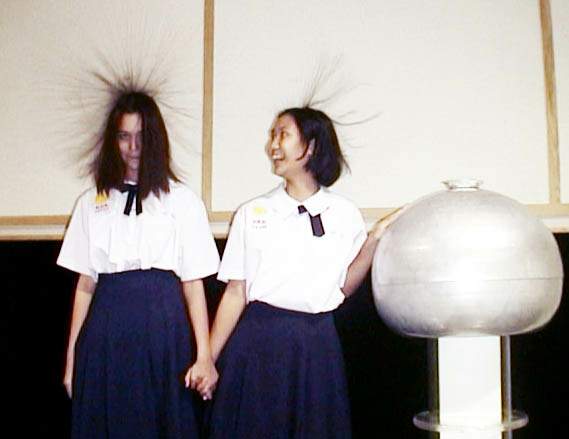
|
Electric Field
| A positive or negative charge produces an electric field in the
space surrounding the charge. Any other charge in the electric field experience
an electric force acting on it. Electric field
is a region within which electric force acts on a particle with an electric
charge. Electric field can be represented by arrow lines
as shown in the diagram below. The
lines are called electric field lines or electric lines of force. More electric
field lines represent stronger electric field. The further it is from the charge
particle, the weaker is the electric force. The direction of electric field lines is from the positive charge towards the negative charge. The electric field lines do not cross each other. The closer the lines, the stronger the electric field is.
|
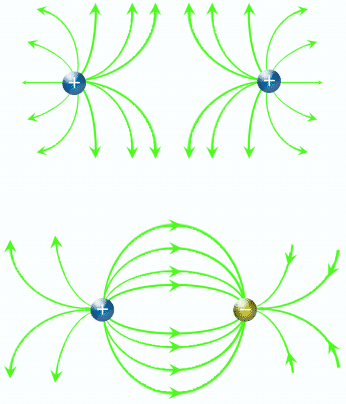
|
|
The effect of an Electric Field |
|
| A charged ball in an electric field A ping pong ball which is coated with a metallic paint is hung between two metal plates by a nylon thread (an insulator). The positive and negative terminals of a high voltage supply are connected to each of the two plates respectively. The ball is displaced towards the negative plate. When it touches the negative plate, it receives electrons and becomes negatively charged. The negatively charged ball is repelled by the negative plate and is attracted by the positive plate. When the ball touches the positive plate, its negative charge is neutralised and it is immediately charged positive. The positively charged ball is repelled by the positive plate and is attracted by the negative plate. The ball moves towards and touches the negative plated and the cycle is repeated. The ball oscillates until the voltage supply is turned off.
|
A candle flame in an electric field The candle flame flattens and spreads out in both directions. The heat of the burning gases ionises the air into positve and negative ions. The postive ions are pulled towards the negative plate while the negative ions are pulled towards the positive plate. The portion of the flame that is attracted to the negative plate is bigger because positive ions are bigger and heavier. |
Electric Current
A circuit is a closed loop through which
charges can continuously flow. External circuit is the path taken by the charges
outside the cell or the battery. Internal circuit is the path within the cell or
the the battery. The direction in the external circuit of a current by convention
is from the positive terminal of an electric cell or
battery to the negative terminal. Actually the electromotive force (E.M.F.) of the cell
or the battery causes the negatively-charged electrons to flow from the negative
terminal to the positive terminal through the wire. In general current is define
as the rate of flow of electric charge. 
A current in a circuit is 1 Ampere if the charge is flowing at the rate of 1 Coulomb per second. Q=It, 1 C = 1A x 1s = 1As. A coulomb is the charge which passes any point in a circuit when a steady current of 1 Ampere is flowing in 1 second.
T
6.25 x 1018
Potential difference
The potential difference, V, between points A and B can be
defined as the work done in moving a unit charge from
one point to another point in an electric field.

The unit of potential difference is Volt, V. The potential difference between two points is 1 Volt if 1 Joule of work is required to move a charge of 1 Coulomb from one point to the other.
Potential difference is measured by a Voltmeter. Voltmeter is connected in parallel with or across a resistor.
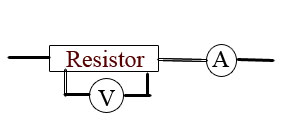
Ohm's Law
|
Ohm's Law states that the electric current, I flowing through a
conductor is directly proportional to the potential difference across
the ends of the conductor, if temperature and other physical conditions
remain constant. V∞ I. V=IR. Gradient of the graph is the resistance of a conductor, R. Resistance of a conductor, R is a measure of the ability of the conductor to resist the flow of an electric current through it. The unit of resistance is ohm, Ω.
|
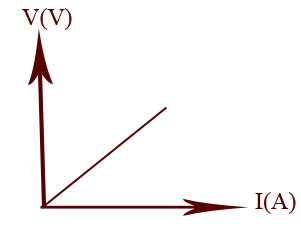 |
|
Factor influencing the resistance of a conductor are:
|
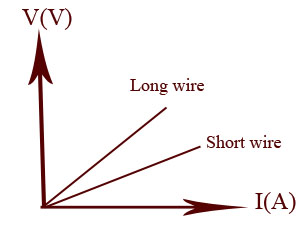

Rlong wire > Rshort wire |
|
|
Rnichrome > Rconstantan > Rcopper > Rsilver |
Super conductor
| Superconductivity was first discovered in
1911, when mercury was cooled to 4 degrees Kelvin by Dutch physicist
Heike Kamerlingh Onnes, which earned him the 1913 Nobel Prize in
physics. Superconductor is an element, inter-metallic alloy or compound that will conduct electricity without resistance at a certain temperature called Critical Temperature, Tc. This enable superconductors to maintain a current with no applied voltage at that temperature. The resistance of a metal conductor decreases when its temperature decreases. For certain materials like aluminium, the resistance decreases with temperature but the resistance suddenly becomes zero when it is cooled below certain temperature called the Critical Temperature, Tc. The critical temperature is normally a few degrees above the absolute zero (0K / -273 degree celcius). Materials showing this characteristics are known as Superconductor. Recently high temperature superconductors have been discovered. These superconductors have critical temperatures of about 100K and above. These temperature are relatively easy to reach with today's technology. |
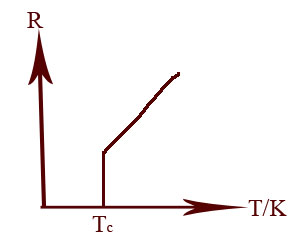 |
| When a small permanent magnet is moved above a superconductor, a
current is induced inside the superconductor. The magnetic field
produced by the superconductor is opposite in direction to the permanent
magnet. The magnetic field of the magnet is expelled from the
superconductor. Click here to view how the magnetic field is expelled. Therefore it floats above the magnet.
Click here to view video of a model Maglev train.
|
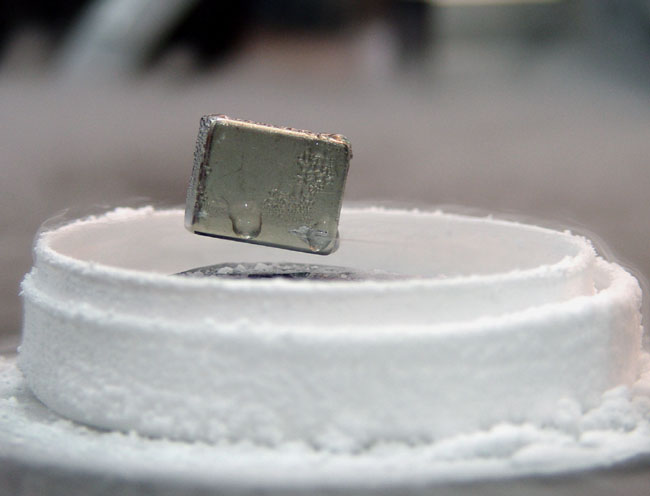 A superconductor floating on a permanent magnet |
Applications of
superconductors:
|
|
[Online multimedia & experiment] [Charged particle in a magnetic field]
[Lessons learned from Thomas Edison's life]